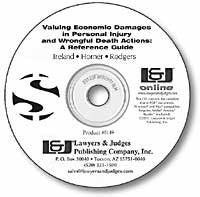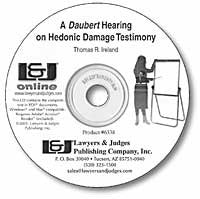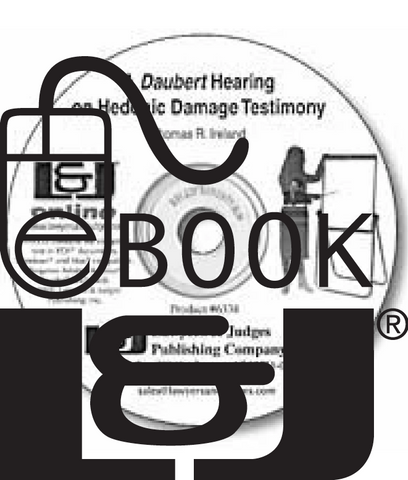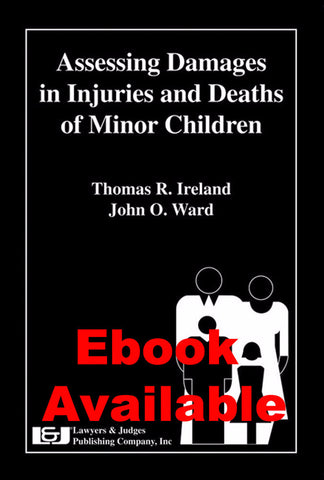
Valuing Economic Damages in PIWDA
When someone is wrongfully injured or killed, how does one calculate the damages that are owed by the offender? This latest work gives you everything you need to know when you are handling a case focused on damages. The issue of damages becomes complicated based on the person’s employment status, age, and residual employment skills after the injury. You will learn about the different types of economic loss such as earnings, fringe benefits, and household services. In addition to expert economists, one must also consult other experts, such as vocational experts. Dr. Ireland explains the roles of these experts so that you understand exactly how they can help you with your case. On this CD, you will also learn about the many considerations that expert economists have when trying to calculate a person’s damages.
TOPICS INCLUDE
- Elements of economic loss in personal injuries
- Analysis of income/payroll taxes and work expenses
- Analysis of loss of household (nonmarket) production capacity
- Necessitated medical and "life care" costs
- Analysis of job-related fringe benefits/financial support
- Analysis of seasonal consumption and maintenance
- "Willingness-to-pay" studies and the derivation of hedonic damages
- Forms of hedonic damage testimony in litigation
- Personal injury uses of hedonic damage testimony
- Conceptual criticisms of hedonic damages
Table of Contents
Valuing Economic Damages in Personal Injury and Wrongful Death Actions:A Reference Guide
Thomas R. Ireland, Stephen M. Horner and James D. Rodgers
General Introduction
I. Purpose of this Reference Guide
II. The Role of Economic Experts in Personal Injury and Wrongful Death/Survival Actions
III. Qualifications of Economic Experts
Part One: Loss Valuation for a Personal Injury
I. Elements of Economic Loss In Personal Injuries
A. Introduction to Part One
B. Related experts who might be needed
C. Types of loss elements in a personal injury analysis
1. Earnings loss
2. Fringe benefit loss
3. Lost household (nonmarket) services
4. Necessitated life care costs
D. Special cases (children, homemakers, retired persons)
II. Analysis of Lost Earnings
A. Identifying the standard for loss
1.Expected earnings versus earnings capacity
2. Consistency of standard
B. Determination and analysis of past earnings and employment activity
C. Projection of pre-injury and post-injury career tracks
1. Working with a vocational expert report
2. Working with other vocational assumptions
3. Special cases: children, homemakers, and retired persons
D. Determination of earnings bases for each career track
1. Earnings path before the injury
2. Earnings path after the injury
E. Accounting for life cycle earnings effects
F. Accounting for duration of working life and unemployment
1. The statistical worklife expectancy (SWLE) method
2. The LPE system
G. Projecting earnings increases and discount rates
1. Methods allowed in Jones &Laughlin v. Pfeifer
2. The relevance of historical rates in projections
3. General wage increases and life cycle effects
4. Differences in risk standards for selecting discount rates
5. Issues relating to the taxability of interest on awards
III. Analysis of Job-Related Fringe Benefits
A. Assessing discretionary fringe benefits
1. Avoiding double counting in discretionary fringe benefits
2. Counting or not counting unused or activated fringe benefits
3. Employer cost versus replacement cost
4. Establishing values for special benefits
5. Establishing a base and projecting lost discretionary benefits
B. Assessing legally mandated fringe benefits
1. Medicare payroll tax payments by an employer
2. Social security payroll tax payments by an employer
3. Seasonal unemployment benefits received by workers
IV. Analysis of Income and Payroll Taxes and Work Expenses
A. Accounting for income and payroll taxes
B. Accounting for work expenses
V. Analysis of Loss of Household (Nonmarket) Production Capacity
A. Primary homemakers as household producers
B. Methodologies for measuring household (nonmarket) production
1. Replacement cost approaches
2. Opportunity cost approaches
3. An index method for estimating reduced household production
4. The percentage reduction method
5. "Worklife expectancy" for household production
C. Projection problems with reduced household production activity
VI. Necessitated Medical and "Life Care" Costs
VII. Report of Past and Future Loss
Part Two: Loss Valuation in Wrongful Death and Survival Actions
I. Elements of Economic Loss in Wrongful Death and Survival Actions
A. Introduction to Part Two
B. Loss standards in wrongful death and survival actions
C. Related experts who might be needed
D. Loss elements in death cases
E. Special cases (children, homemakers, retired persons)
II. Analysis of Lost Earnings/Financial Support
III. Analysis of Job-Related Fringe Benefits/Financial Support
A. Four examples of non-fringe benefit loss by survivors
B. Pension benefit loss in the case of a retired person
IV. Analysis of Work Related Expenses and Income Taxes
V. Analysis of Lost Household (Nonmarket) Production
A. Loss of non in-home services
B. Determining personal consumption for lost nonmarket production
C. The investment approach for parental loss in the death of a child
VI. Analysis of Personal Consumption and Maintenance
VII. Reporting Past and Future Loss
Part Three: Hedonic Damages
I. Introduction
II. The Nature of Losses from Death or Personal Injury
III. "Willingness-to-Pay" Studies and the Derivation of "Hedonic Damages"
IV. Technical Issues with Willingness-to-Pay Studies
A. Issue #1: Consumer purchases that affect the safety of more than one life
B. Issue #2: Separation of fatality risk from injury and property risk
C. Issue #3: Kahneman-Tversky problems
D. Issue #4: Industry risk versus occupational risk in wage-risk studies
E. Issue #5: Problems relating to econometric studies
F. Issue #6: Wide range of estimates
G. Issue #7: Qualities of surveys of the literature
H. Issue #8: The tailoring issue
V. Forms of Hedonic Damage Testimony in Litigation
A. The "whole value of life" method
B. The "annualized value of enjoyment" method
C. Deterrence value of life testimony
VI. Personal Injury Uses of Hedonic Damage Testimony
VII. Conceptual Criticisms of Hedonic Damages
A. The inability to compensate a dead person
B. Unsatisfactory nature of the linearity assumption
VIII. Conclusion
Glossary
General References
Important Cases
Boucher v. Suzuki (2d Cir.pdf
Chapman v. Maytag (7th Cir).pdf
Chesapeake &Ohio R Co v. Kelly.pdf
Coastal Fuels v. Caribbean Petroleum (1st Cir).pdf
Concord Boat v. Brunswick.pdf
Daubert v. Merrel Dow.pdf
Eichel v. NYC RR.pdf
Elcock v. K-Mart (3d Cir.).pdf
Erie R. Co. v. Tompkins.pdf
Flemming v. Nestor.pdf
General Electric v. Joiner.pdf
Jones &Laughlin v. Pfeifer.pdf
Kumho v. Carmichael.pdf
Mich CRR v. Vreeland.pdf
Miles v. Apex Marine.pdf
Monessen v. Morgan.pdf
Norfolk &Western v. Liepelt.pdf
Richardson v. Belcher.pdf
Schneider v. County of San Diego.pdf
Sea-Land v. Gaudet.pdf
Blue Dane Simmental v. American Simmental (8th Cir).pdf
St. Louis SW R. Co. v. Dickerson.pdf
Toyota v. Williams.pdf
Weinberger v. Wisenfeld.pdf
Weisgram v. Marley.pdf




